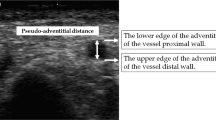Abstract
Catheter angioplasty or angiography via the distal access point of the radial artery (dRA), located at the anatomical snuff box, is a less invasive strategy for coronary intervention attracting considerable attention. Determining the diameter of the dRA is necessary to minimize the risk of artery occlusion and safely perform catheter intervention. This was a retrospective observational study including patients who underwent coronary angiography or coronary intervention at Aomori Kyoritsu Hospital, Aomori, Japan, between February 2018 and August 2018. The diameter of the dRA and the conventional access point of the radial artery (cRA) at the wrist of the patients were measured using ultrasound prior to angiography or interventional procedure. A total of 120 patients were analyzed. In male patients, the diameters of the cRA and dRA were 2.62 ± 0.60 mm and 2.04 ± 0.43 mm, respectively. In females, these diameters were 2.44 ± 0.51 mm and 1.96 ± 0.44 mm, respectively. Overall, the dRA was statistically significantly smaller than the cRA. However, variations were observed, with eight patients (6.7%) having a larger dRA than cRA. The diameter of the dRA indicated only that of the cRA. A multivariate analysis did not reveal factors associated with vessel diameter. The size and anatomy of the dRA varied considerably. Thus, it is difficult to predict the actual diameter of the artery. Customized selection of the size of the sheath and site of intervention is essential for each patient to safely perform ultrasound examination prior to cannulation.



Similar content being viewed by others
References
Kiemeneij F, Laarman G. Percutaneous transradial artery approach for coronary stent implantation. Cathet Cardiovasc Diagn. 1993;30(2):173–8.
Valgimigli M, Gagnor A, Calabró P, Frigoli E, Leonardi S, Zaro T, et al. Radial versus femoral access in patients with acute coronary syndromes undergoing invasive management: a randomised multicentre trial. Lancet. 2015;385(9986):2465–76.
Bavishi C, Panwar SR, Dangas GD, Barman N, Hasan CM, Baber U, et al. Meta-analysis of radial versus femoral access for percutaneous coronary interventions in non-st-segment elevation acute coronary syndrome. Am J Cardiol. 2016;117(2):172–8.
Saito S, Miyake S, Hosokawa G, Tanaka S, Kawamitsu K, Kaneda H, et al. Transradial coronary intervention in Japanese patients. Cathet Cardiovasc Interv. 1999;46(1):37–41.
Kiemeneij F. Left distal transradial access in the anatomical snuffbox for coronary angiography (ldTRA) and interventions (ldTRI). EuroIntervention. 2017;13(7):851–7.
Yoshimachi F, Kiemeneij F, Masutani M, Matsukage T, Takahashi A, Ikari Y. Safety and feasibility of the new 5 Fr Glidesheath Slender. Cardiovasc Interv Ther. 2016;31(1):38–41.
Tang L, Wang F, Li Y, Zhao L, Xi H, Guo Z, Li X, et al. Ultrasound guidance for radial artery catheterization: an updated meta-analysis of randomized controlled trials. PLoS ONE. 2014;9(11):e111527.
Sobolev M, Slovut DP, Lee Chang A, Shiloh AL, Eisen LA. Ultrasound-guided catheterization of the femoral artery: a systematic review and meta-analysis of randomized controlled trials. J Invasive Cardiol. 2015;27(7):318–23.
Acknowledgements
The authors thank the members of the cardiac catheterization laboratory and the ultrasound examination room.
Author information
Authors and Affiliations
Corresponding author
Ethics declarations
Conflict of interest
The authors declare that they have no conflict of interest.
Ethical approval
All procedures performed in studies involving human participants were in accordance with the ethical standards of the institutional and/or national research committee and with the 1964 Helsinki Declaration and its later amendments or comparable ethical standards. The study protocol was reviewed and approved by the ethics committee of Aomori Kyoritsu Hospital.
Additional information
Publisher's note
Springer Nature remains neutral with regard to jurisdictional claims in published maps and institutional affiliations.
Rights and permissions
About this article
Cite this article
Naito, T., Sawaoka, T., Sasaki, K. et al. Evaluation of the diameter of the distal radial artery at the anatomical snuff box using ultrasound in Japanese patients. Cardiovasc Interv and Ther 34, 312–316 (2019). https://doi.org/10.1007/s12928-018-00567-5
Received:
Accepted:
Published:
Issue Date:
DOI: https://doi.org/10.1007/s12928-018-00567-5




